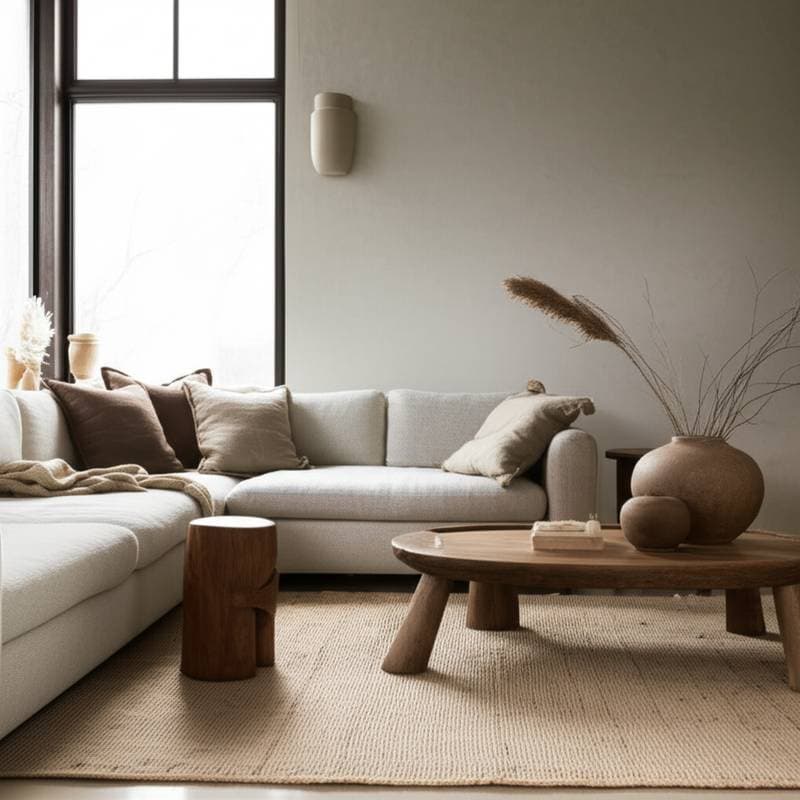Wabi-Sabi's Imperfect Charm Transforms 2025 Homes
Many people enter a room and immediately sense tranquility, despite the absence of polished surfaces or recent purchases. Perhaps the space features a textured wooden table, a vase with subtle fissures, or linen drapes softened by sunlight. This serene quality embodies Wabi-Sabi, a design philosophy that honors imperfection, simplicity, and the inherent beauty of nature.
Homeowners increasingly adopt Wabi-Sabi principles to escape the demands of sleek, flawless aesthetics. This approach embraces the patina of time, the authenticity of materials, and the ease of unpretentious living. For those weary of relentless upkeep or pristine uniformity, Wabi-Sabi provides a liberating path to genuine comfort.
Why Wabi-Sabi Aligns with Contemporary Lifestyles
Contemporary residences frequently reflect the haste of daily routines, with overflowing surfaces and perpetual renovation lists. Wabi-Sabi counters this frenzy by promoting harmony with existing possessions and appreciation for gradual evolution. It shifts focus from acquisition to mindful inhabitation, fostering spaces that support rather than overwhelm.
Central to this philosophy are natural elements, subdued palettes, and raw textures. The result is an environment that appears curated yet effortless, rooted in reality rather than illusion. Homeowners achieve elegance without the burden of constant perfection.
Essential Components of Wabi-Sabi Interiors
Understanding the foundational aspects of Wabi-Sabi guides effective implementation. These principles form the backbone of spaces that exude quiet authenticity.
- Simplicity: Retain items that serve a purpose or evoke joy. Decluttered surfaces and ample negative space promote mental clarity and visual ease.
- Natural Materials: Select timber, earthenware, flax fibers, stone, or wool. Such choices develop appealing patina over years and offer tactile warmth.
- Subdued Hues: Opt for gentle neutrals like slate, ivory, taupe, or washed sage. These tones establish a restful foundation without overwhelming the senses.
- Artisanal Details: Incorporate hand-thrown ceramics, braided containers, or custom-glazed surfaces. These elements infuse uniqueness and narrative depth.
- Embraced Patina: Treat subtle wear, oxidation, or irregularities as assets. They signify history and active use, enhancing the room's character.
Together, these features yield interiors that resonate with honesty, evoking a sense of enduring habitation over transient display.
Incorporating Wabi-Sabi Principles into Your Residence
Significant overhauls prove unnecessary for adopting Wabi-Sabi. Targeted adjustments suffice to infuse serenity and authenticity. Follow these steps for gradual transformation.
1. Streamline Your Environment
Examine primary areas such as the living room or kitchen. Identify objects that demand excessive effort or fail to contribute meaningfully. Remove or rehome them systematically, perhaps over a dedicated afternoon.
Prioritize unobstructed pathways and bare expanses. These voids invite repose, allowing focal points like a single artwork or plant to emerge naturally.
2. Integrate Authentic Textures and Forms
When refreshing furnishings or accents, favor items with inherent integrity. A reclaimed oak side table, for instance, surpasses synthetic alternatives in durability and evolving appeal.
Incorporate terracotta vessels, unbleached upholstery, or sisal flooring. Their gradual weathering enhances rather than detracts from the overall harmony.
3. Apply Restrained, Earthy Tones
Select wall coverings in benign shades such as linen white, clay beige, or muted ochre. Introduce subtle variation via fabrics, vessels, or subtle prints.
Avoid vivid or artificial colors that disrupt equilibrium. The palette aims to envelop occupants in gentle, restorative ambiance.
4. Celebrate Subtle Imperfections
Preserve and enhance existing signs of age. Refinish a scuffed bench with natural oils to highlight its grain, transforming it into a cherished focal point.
Seek out artisan goods from local makers, where slight asymmetries in form or finish denote craftsmanship. These details distinguish the space from mass-produced uniformity.
5. Infuse Organic Vitality
Introduce low-maintenance greenery to vitalize the interior. A potted olive tree, bundle of preserved branches, or compact succulent suffices to bridge indoors and out.
Maximize daylight by employing sheer fabrics or minimal frames. This illumination accentuates textures and fosters a fluid connection to the external world.
Advantages and Limitations of Wabi-Sabi Design
Every aesthetic carries strengths and potential drawbacks. Awareness of these informs balanced adoption.
Advantages
- Fosters tranquil, undemanding surroundings
- Promotes ecological responsibility via restoration and longevity
- Reduces expenses by de-emphasizing flawless replacements
- Cultivates intimate, enduring appeal
Limitations
- Risks appearing unkempt without deliberate curation
- May confuse observers who equate it with disrepair
- Demands occasional upkeep for organic components, such as conditioning timber or laundering fibers
Equilibrium remains essential. Excess austerity might unsettle, while undue refinement dilutes the philosophy's essence.
Preparatory Factors for Implementation
Financial Planning: This style accommodates diverse budgets. Minimal interventions, like reorganizing possessions, incur little cost. Targeted investments in durable artisanry might range from $200 for accents to $3,000 for comprehensive updates.
Timeline and Commitment: Initial purging requires focused sessions, perhaps spanning two days per area. Subsequent care simplifies, emphasizing preservation over perpetual renewal.
Required Expertise: Basic knowledge suffices for most applications, including simple refinishing or color testing. Engage specialists for structural alterations, such as flooring installation or custom joinery.
Health and Safety: Inspect vintage elements for outdated treatments like varnishes containing hazards. Use masks and ventilation during surface preparation to ensure well-being.
Experiencing Wabi-Sabi in Daily Life
As Wabi-Sabi permeates your home, subtle shifts in routine emerge. Concerns over minor blemishes fade, replaced by delight in sunlight grazing uneven plaster or the heft of a crafted vessel.
This philosophy nurtures mindfulness and contentment. Adaptations occur organically, with spaces evolving alongside personal circumstances. It prioritizes being over striving, where each nuance enriches the narrative of dwelling.
Steps to Initiate Your Wabi-Sabi Journey
Commence modestly by selecting a single area, such as a lounge or repose chamber. Eliminate excess, temper the palette, and elevate natural forms.
Observe the resulting poise and ease. Progress incrementally, allowing each enhancement to deepen the sanctuary. Wabi-Sabi affirms that true elegance arises from sincerity, ease, and the graceful acknowledgment of life's textures.
